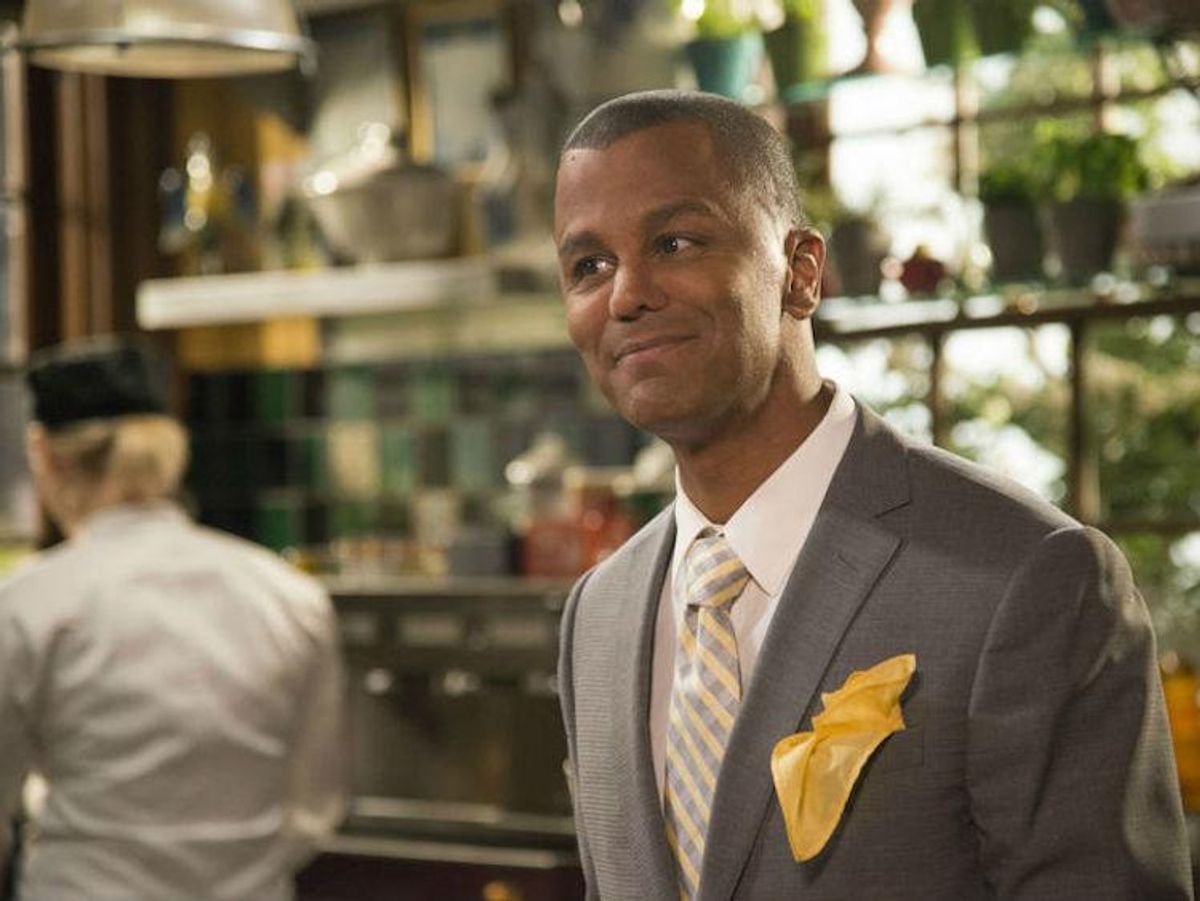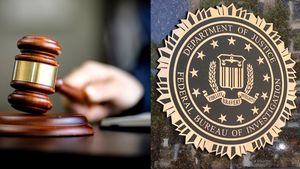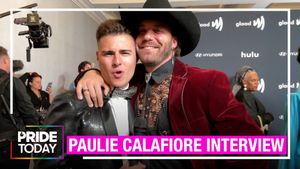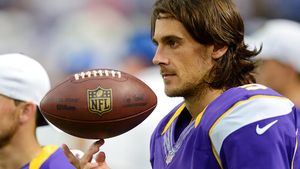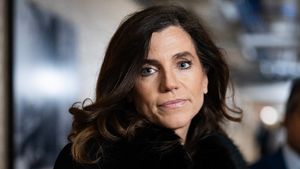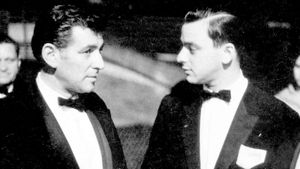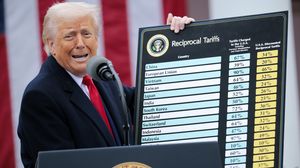Netflix's hotly anticipated revival of Gilmore Girls answered one of fans' most burning unanswered questions: Is Michel Gerard gay or is he just French?
Michel (Yanic Truesdale), the malcontent concierge at the Dragonfly Inn, never got a love life in the original series, which aired on the WB (and later the CW) from 2000 to 2007. The beloved dramedy occasionally alluded to an offscreen romantic interest for the perpetually perturbed Frenchman, but in each instance, it's casually implied the object of his affections is female. In season one's "Star-Crossed Lovers and Other Strangers," Michel refers to his soon-to-be date as "cherie" over the phone during a shift at the Independence Inn. If the person on the other end of the phone were a man, he would likely address them as "cher."
Despite all evidence to the contrary, it was clear that Gilmore Girls at least wanted viewers to read Michel as gay. The character is fashionable, witty, and loves Celine Dion. Prior to attending her Vegas show, Michel quivers, terrified he won't impress his favorite diva. "What should I wear?" he asks Lorelai Gilmore (Lauren Graham), his boss and best frenemy. "What would Celine like me in?" If the show defines queerness as a love for "all things frilly," as alluded to in "Kill Me Now," Michel certainly conforms to the stereotype.
In Gilmore Girls: A Year in the Life, which hit Netflix last Friday, Michel doesn't have his coming out moment. He's already a proud, happily married gay man. His partner, Frederic, wants a child, but Michel, who doesn't like adults very much, let alone children, is wary of starting a family. "I just don't understand it," Michel moans. "Before we got married, Frederic was more indifferent to children than I am."
This moment is an attempted mea culpa for the show's complete lack of LGBT representation throughout its seven season run, even despite having a sizable queer fanbase. Gilmore Girls, which didn't have a single out character, was marred by an unfortunate tendency to make frequent jokes at the expense of gay, lesbian, and transgender people. Although the program was a product of its time, the Netflix revival shows Gilmore Girls taking steps to bring Stars Hollow into 2016--if uneasily so.
Gilmore Girls was created by Amy Sherman-Palladino, who got her start as a writer for Roseanne. The hit program was a notable trailblazer when it came to bringing the LGBT community to the small screen. In 1995, Roseanne became the first sitcom to portray a same-sex wedding on television, a year before Ross' ex-wife Carol (Jane Sibbett) and Susan (Jessica Hecht) tied the knot on Friends. While the Friends episode is notable for its lack of same-sex intimacy, Roseanne even allowed Leon (Martin Mull) and Scott (Fred Willard) a post-nuptial smooch. The show also had a lesbian recurring character, Nancy, played by Sandra Bernhard.
Related | A Timeline of (Nearly) Every LGBT Couple in TV History
Sherman-Palladino originally conceived of Gilmore Girls as being as LGBT inclusive as her previous project. After she pitched the idea of a "show about a mother and daughter, but they're more like best friends" to the WB, she found that the network balked at a lesbian best friend for Lorelai, an inn owner who left home at sixteen after getting pregnant with Rory (Alexis Bledel). Sookie St. James (Melissa McCarthy), the chef at the Independence Inn, was originally supposed to be queer--and played by Mad TV's Alex Borstein.
The show's creator claimed that Sookie's sexual orientation was a "non-starter" for the youth-oriented network, which had only recently tiptoed into LGBT representation. Although Jack McPhee (Kerr Smith) had recently come out on the WB's Dawson's Creek, there were few other characters like him on television. Buffy the Vampire Slayer's Willow Rosenberg (Alyson Hannigan), Sunnydale's resident bookish witch, came out just months before Gilmore Girls debuted.
Sixteen years later, the television landscape has changed dramatically. Shows like Transparent, How to Get Away With Murder, Empire, and Orange Is the New Black have pushed boundaries when it comes to the inclusion of LGBT storylines without sacrificing viewers. Network television has become so inclusive that GLAAD, the national nonprofit that lobbies for LGBT representation in film and television, disbanded its annual "Network Responsibility Index" in favor of focusing on the racial diversity of LGBT characters.
Related | TV Has More Trans Characters, But Still Failing Queer Women (Report)
If network resistance forced Stars Hollow's gay characters into the closet, the Gilmore Girls revival acknowledges that the show found itself behind the times. At a town meeting, selectman Taylor Doose (Michael Winters) announces that Stars Hollow will be holding its first-ever gay pride parade. The problem is that very few LGBT people live in the small Connecticut town. Stars Hollow has just one lesbian couple--who isn't shown on screen--and Donald (Sam Pancake), who was not in the original series. Michel, whose sexuality is retconned in the reboot to make the series more inclusive, doesn't live in the town.
The town is befuddled by this shocking revelation. "How is that possible?" Lorelai protests. "We have such cute houses!" Babette (Sally Struthers) interjects. As BuzzFeed's Louis Peitzman writes, "It's not the most nuanced joke, but it does at least allow the show to look at its past failings a bit more critically."
According to Sherman-Palladino, the show had characters throughout its run that the writers and producers "thought of as gay." Their sexuality was just never explicitly addressed one way or the other. There's Michel's nemesis, Tobin (Bruce McCulloch), the effete night manager at the Independence Inn who acts as a rival for Lorelai's affections. When Sookie becomes pregnant with her first child in season four, a butch midwife named Bruce (Rusty Schwimmer) helps her prepare to be a mother.
When it came to Michel, though, the actor who plays him has said that even he wasn't sure about the character's personal life during the original run. "I never actually asked Amy," Truesdale told The Huffington Post last year. "I've never asked, swear on my mother's head." He wasn't aware Michel was gay until he read the script for A Year in the Life.
The show's LGBT failings weren't just about queer visibility. Throughout the show, the word "gay" is interchangeable with "weird" or "uncool." When Kirk (Sean Gunn) wears a purse to Luke's Diner, the restaurant's swarthy namesake (Scott Patterson) asks, "What's with the gay bag?" Jason Stiles (Chris Eigeman), Lorelai's season four love interest, refers to waltzing as "embarrassing and a little gay." Lane's (Keiko Agena) bandmate and husband, Zach (Todd Lowe), refers to a hymn penned by Martin Luther as being "totally gay."
What's more egregious than Gilmore Girls' middle school understanding of queer people is the show's strange discomfort and even disdain for LGBT people. While the show is avowedly feminist, it's downright conservative when it comes to sexuality.
In the aforementioned "Kill Me Now," one of the series' earliest episodes, Rory goes to the country club with her grandfather, Richard (Edward Herrmann), in order to learn how to play golf. She needs to be involved in school athletics at Chilton to round out her application for Harvard, Rory's dream school. (Spoiler: She winds up at Yale instead.) While taking a steam, she overhears some juicy gossip from the other women at the club: Mr. Neville, a character also unseen, is gay. The elder Gilmore groans at the revelation. "Good god," Richard says, putting his hand to his forehead as if he has a headache. "He's my broker."
The scene is similar to an aside in season three's "The Big One," when Lorelai runs into her ex-fiancee, Max (Scott Cohen), who also happens to be Rory's teacher at Chilton. After Max witnesses Paris (Liza Weil) have a breakdown at a school event, he tells Lorelai that he just "realized it must be really hard to be a girl." Lorelai claims that it's not so bad. "At least we get to wear skirts without being Scottish or riding a float in the gay pride parade," she retorts.
Gilmore Girls follows by taking a swipe at gender nonconforming people. "That'll change someday, my friend," Max says. "When it does, I still won't wear a skirt, but I'll applaud those that do. And then cross the street so nobody sees I'm with them."
A Year in the Life is refreshingly free of jokes that use gay people as punchlines, but trans folks don't get off so easy. Rory goes off on one last ride with the Life and Death Brigade, a band of merry pranksters whose ranks she reservedly joins in college after doing a story for the Yale Daily News on the group. During their adventure, Finn (Tanc Sade), the Aussie member of the wild bunch, begins dancing with a young woman at a tango club. He's informed by Robert (Nick Holmes) that his dance partner is "a guy." Finn replies, "Only 'til next Tuesday."
If Gilmore Girls hasn't quite outgrown its worst habits, that's a shame. What's long appealed to queer viewers about the show isn't that it's filled with sharp, witty women who obsess over Barbra Streisand and Grey Gardens. Gilmore Girls is a love letter to outsiders--from the Korean audiophile who hides her music collection from her religious mother or the teenage outcast who leaves home to build her own community of misfits and weirdos.
"What's there not to love about Stars Hollow?" the revival asks during a musical number. Gilmore Girls, one of the freshest and funniest shows ever to air on television, remains deservedly adored by its fans, but for queer viewers, the answer to that question may be more complicated than it seems.
